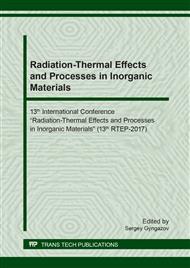p.70
p.76
p.82
p.88
p.95
p.101
p.108
p.114
p.119
Surface Doping of Steel with an Intense Pulsed Electron Beam
Abstract:
Surface doping of AISI420 steel is carried out in a single vacuum cycle, and consisted of spraying a thin (0.5 μm) film of Zr-Ti-Cu alloy by electric-arc sputtering of a cathode of the composition Zr-6 at.% Ti-6 at.% Cu, and the subsequent irradiation of the system “film (Zr-Ti-Cu alloy) / (AISI420 steel) substrate” with an intense pulsed electron beam. It is shown that the concentration of zirconium in the surface layer of steel decreases with an increase in the energy density of the electron beam (ES). It is established that formation of a surface alloy is accompanied by the following: formation of a cellular crystallization structure (the average cell size increases from 150 nm at ES = 20 J/cm2 to 370 nm at ES = 40 J/cm2); formation of a dendritic crystallization structure in the presence of refractory element particles (titanium or zirconium); decomposition of a solid solution with the release of zirconium carbide particles (particle sizes increase from (10-15) nm at ES = 20 J/cm2 to (30-40) nm at ES = 40 J/cm2). Particles of the carbide phase based on chromium of the composition Cr3C2, Cr7C3 and (Cr, Fe)23С6, along with zirconium carbide particles, are revealed upon the irradiation of the system “film (Zr-Ti-Cu alloy) / (AISI420 steel) substrate” with an intense pulsed electron beam (ES = 40 J/cm2). Chromium carbide particles have a round shape; their sizes vary from 40 nm to 60 nm. The analysis of phase transformation diagrams taking place under equilibrium conditions in systems Fe-Zr-C; Cr-Zr-C; Fe-Cr-Zr is carried out. It is established that ultra-high cooling rates that occur during the irradiation of the system “film (Zr-Ti-Cu alloy) / (AISI420 steel) substrate” with an intense pulsed electron beam impose restrictions on formation of phases of the intermetallic type. It is suggested that formation of predominantly carbide phases in the surface layer of the material is conditioned upon high mobility of carbon atoms in steel.
Info:
Periodical:
Pages:
95-100
Citation:
Online since:
September 2018
Price:
Сopyright:
© 2018 Trans Tech Publications Ltd. All Rights Reserved
Share:
Citation:


